
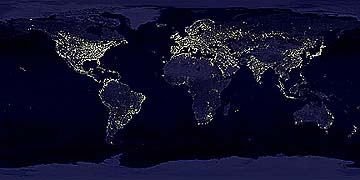
Weekly Online Fanzine Issue 0554 ERB ECLECTICA ~ MOTES & QUOTES ERB-Date: 2001.01.19 |


Weekly Online Fanzine Issue 0554 ERB ECLECTICA ~ MOTES & QUOTES ERB-Date: 2001.01.19 |
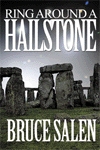 |
He continues to write mystery novels that are both intriguing and suspenseful. He resides in Brooklyn, New York. Watch for Bruce's soon-to-be-published,
second mystery novel:
|
|
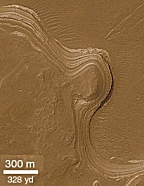 |
--raising hopes that life could have arisen there-- but the evidence remains inconclusive and sometimes contradictory References:
|
January 5, 2001 -- Mars may once have been a very wet place. A host of clues remain from an earlier era, billions of years ago, hinting that the Red Planet was host to great rivers, lakes and perhaps even an ocean. But some of the clues are contradictory -- they don't all fit together in a coherent whole. Little wonder, then, that the fate of water on Mars is such a hotly debated topic.The reason for the intense interest in Martian water is simple: Without water, there can be no life as we know it. If it has been 3.5 billion years since liquid water was present on Mars, the chance of finding life there is remote. But if water is present on Mars now, however well hidden, life may be holding on in some protected niche.
Right: Sedimentary rock layers like these in Mars's Holden Crater suggest that the Red Planet was once home to ancient lakes. [more information]
Based on what we have observed so far, Mars today is a frozen desert. It's too cold for liquid water to exist on its surface and too cold to rain. The planet's atmosphere is also too thin to permit any significant amount of snowfall.
Even if some internal heat source warmed the planet up enough for ice to melt, it wouldn't yield liquid water. The Martian atmosphere is so thin that even if the temperature rose above freezing the ice would change directly to water vapor.
Signs of Heavy Flooding
But there must have been water, and plenty of it, in Mars's past. That is evident from the massive outflow channels that are found, mostly, in the northern lowlands. The intensity of the floods that carved these channels was tremendous, perhaps reaching discharge rates as high as 10,000 times that at which the Mississippi, when flooded, pours into the Gulf of Mexico.
What caused these giant floods? Was it a climate change, perhaps brought about by a change in Mars's orbit? Or was the planet's own internal heat responsible? And, whatever mechanism caused the floods in the first place, where has all that water gone? Was it absorbed into the ground where it remains today, frozen? Or did it dissipate into the Martian atmosphere, where it was subsequently lost to space? No-one knows for certain the answers to these questions.
Some scientists believe that the catastrophic floods that carved the outflow channels occurred nearly simultaneously, releasing such vast quantities of water that they merged into an ocean that covered the northern lowlands. Tim Parker of NASA's Jet Propulsion Laboratory first proposed such an idea in 1989. Parker, examining images taken by the Viking Orbiters, found what he believed were remnants of two ancient ocean shorelines, which he called "contacts," one inside the other, in the Martian north.
Expanding on this notion, in 1991 Vic Baker of the University of Arizona, suggested that Mars might not be geologically dead and permanently frozen. Instead, he proposed, Mars might undergo cycles, or pulses -- first heating up, releasing groundwater and forming an ocean in the north, then dissipating the ocean back into the planet's crust and re-freezing.
| More recently, Jim Head and colleagues at Brown University, found evidence that is consistent with a shoreline that might indeed have existed at the inner of Parker's two proposed contacts, contact 2. Head and colleagues examined elevation data gathered by the Mars Orbiter Laser Altimeter (MOLA) on board the Mars Global Surveyor (MGS) and found that the elevation at points along contact 2 were much closer to a straight line than those at contact 1. They also found that the terrain below this elevation was smoother than the terrain above it. Both of these findings are consistent with the former presence there of an ocean. | 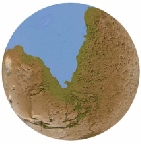 |
But the story doesn't end there. Shortly after Head and colleagues published their findings, Mike Malin and Ken Edgett of Malin Space Systems used the Mars Orbital Camera (MOC) aboard MGS, to take a series of high-resolution images of contact 2 terrain. Their conclusion: there's nothing there.Right: In this topographic drawing of Mars, blue indicates the area where an ocean once may have existed. Credit: NASA Mars Global Surveyor Project; MOLA Team Rendering by Peter Neivert, Brown University
And the debate continues. Says Mike Carr of the U.S. Geological Survey, author of the book Water on Mars, "We're getting all this new data from MGS, and I think a lot of it is just not understood yet. It's very hard to understand. The whole business of the oceans, the evidence is so contradictory."
Mysterious Valleys
Mars's small-valley networks, which occur mainly in the southern highlands, pose another perplexing problem. Scientists who first studied images of these valleys thought they resembled river valleys on Earth. So, they reasoned, a similar process, the runoff of rainwater, must have formed them.
For Mars to be warm enough to rain, however, it would have needed a much thicker atmosphere than it has today. And no-one has come up with a clear-cut explanation for how such an atmosphere could have formed.
One alternative theory is that a process known as sapping, or collapse caused by the softening of the soil by groundwater, created the valleys. Yet another notion is that perhaps glaciers covered the regions around the valleys, and that glacial meltwater carved them. As with Mars's other watery mysteries, however, the question of how the valley networks formed remains unanswered.
And if these vexing problems weren't enough, recent images from MOC reveal a startling new puzzle. In nearly a dozen different locations on Mars - all of them far from the equator - there are signs that water has been seeping out of the walls of valleys and craters, forming small gullies. Some scientists speculate that this activity is very recent, perhaps occurring within the past 10 years; others say 10 million years is more likely.
Yet many aspects of these seepage gullies defy common sense. "They sure look like water-worn features," says Mike Carr, "but they seem to contradict what we know about the stability of water." They occur not only in the coldest regions on Mars, but on slopes facing away from the Sun, where the temperature rarely gets above minus 50 degrees Centigrade. Yet the water appears to be seeping out from only 100 meters below the surface, a depth at which scientists previously believed Mars's crust to be frozen solid. Scientists are busily working to devise an explanation for this phenomenon.
There is one additional thorn in the side of those who study water on Mars. No evidence of carbonates has yet been found anywhere on the planet. Carbonates are minerals that form readily when liquid water reacts with carbon dioxide in the atmosphere. If Mars had abundant liquid water in its past, carbonates should be detectable in the Martian rock record. The Thermal Emission Spectrometer (TES) instrument aboard MGS was designed to look for just such a signature. But so far it has found none. Perhaps other evaporites, such as sulfates (as detected in Martian meteorites and interpreted from landing site analyses), are the dominant material of this type on Mars.What Next?
New debates will undoubtedly emerge as data from Mars Global Surveyor is digested. In 2001, NASA will send a new orbiter to Mars, which will include a higher-resolution spectrometer to search for carbonates. In 2003, NASA will send two rovers to Mars to hunt for water's signatures in rocks and soil on the surface. But many questions about the history of water on Mars are likely to remain unanswered until samples are returned from the Red Planet for examination on Earth. Says Carr, "I think the sample return is what we want, particularly of sediments. And if we could get samples of things like this back on Earth, I think it would do an awful lot to help us understand what's going on [on Mars]."
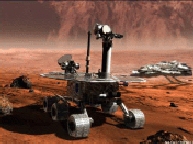 |
 |
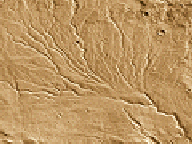 |
Note: An even more recent theory suggests that these
landform markings may have been caused by carbon dioxide.
Nkima and Friends in Space?
One audio clip produced from radio waves that NASA's Cassini spacecraft detected near Jupiter was described last week by the Los Angeles Times as sounding "like a troop of howler monkeys battling underwater." A new audio clip is available online from NASA's Jet Propulsion Laboratory, at: http://www.jpl.nasa.gov/cassini/acoustic
CAUGHT IN OUR SITE:
At the
KEN LOPEZ: BOOKSELLER WEBSITE
http://www.lopezbooks.com/
The Best Edgar Rice Burroughs Archive in Private Hands
http://www.lopezbooks.com/111/111-02.html#BBURROUGHS, Edgar Rice. Archive. An extensive archive of over 2500 items including letters, documents, manuscript notes and materials, unique publications, photographs, and movie memorabilia, spanning the writer's entire life and documenting in great detail the period from the 1920s until his death -- an unparalleled collection that is a trove of scholarly research materials as well as a unique collection of original artifacts of the author's life and career. The only collection comparable to this is that of the author's estate in Tarzana, California, and this one is superior to that in a number of respects and contains the only copies extant of a large number of items that were destroyed by fire in Tarzana. The correspondence is heavy with intimate family and pointed business details; the documents and other memorabilia include personal and professional records, manuscripts and notes for his wartime publications, contracts and checks for his stories. The bulk of the collection is arranged chronologically, in 31 large loose-leaf notebooks. The first three cover the years from his birth to the late 1920s, by which time he was a successful and wealthy author. The other 28 cover the period from 1930-1950, documenting these years in great detail in both family and business matters.
Among the notable items in the collection are: the $700 check Burroughs cashed for the first "Tarzan" story, which he has been quoted as saying was the payment that gave him the confidence to continue writing and to make it a career; one of the estimated half dozen original mimeograph prints Burroughs made of his eyewitness account of the bombing of Pearl Harbor; and a typewritten travel journal of a cross-country trip he took with his family in 1916, illustrated with snapshots. Burroughs was particularly fond of camping in the Canyon Country of the Southwest in the early days of the National Parks, and several such trips are recounted here in typescript, with original photos as illustrations. There's also a map of the layout of the first subdivision of the Burroughs ranch, Tarzana, which later became the town of Tarzana, California. There is great breadth and depth in the area of the author's correspondence, including many retained copies of his own letters which help put the replies in unambiguous context. In addition, there are many significant artifacts of the noted writer's work and career: a privately printed volume of memoirs by the author's mother, illustrated by the author's nephew, and inscribed by Edgar at Christmas, 1914; a set of journal notes from his first airplane flight, written while in flight and with drawings of the sights he saw; his file box from Honolulu, in which he filed his war correspondence, as well a field notebook from his time in the Pacific as a correspondent; and much more.
Burroughs remained in close regular contact with his children even after they were grown, and much of their sustained correspondence is preserved in this collection. The letters not only recount factual information about family and other affairs but often veer into philosophical discourse on such subjects as religion, when the father felt a need or desire to clarify his position on a subject with one of the children. When Burroughs divorced his first wife, Emma -- the children's mother -- the rift in the Burroughs family is visible in the strained correspondence. Burroughs' ultimately successful efforts to reconcile the family can be seen in these years, especially when the Second World War throws all personal questions into a much larger context, and both Burroughs and his eldest son, Hulbert, are squarely in harm's way in the South Pacific theater. After the attack on Pearl Harbor, Burroughs became actively involved in the question of the postwar fate of the interned Japanese-Americans. Originally a staunch supporter of the policy of internment, Burroughs changed his attitude over the course of the war as he realized the racism infecting such "patriotic" attitudes and strove to separate the security concerns from such prejudices. He became a strong advocate for the rights of Japanese-Americans -- a very public change of posture that can be seen to reflect, in its own way, on the question of racism within the Tarzan novels and other Burroughs writings.
In the late 1920s, and especially in the 1930s when talking movies became standard, the Tarzan character reached a whole new audience, even larger than it had in the popular books. A radio series had started in the late 20s, and a comic strip in the 30s, and the archive admirably documents Burroughs' involvement in these enterprises -- sometimes from a distance, watching the studios compete to outdo each others' Tarzan movies, sometimes as a close critic, such as when he critiques a cartoon series his son Jack has gotten involved in with Bob Clampett, the Warner Brothers artist. He also was involved as a principal, being one of the producers of a movie, The New Adventures of Tarzan, shot on location in Central America in the 1930s, an effort fraught with almost unimaginable hardship and an ambitious attempt at realism at a time when the infrastructure of the Caribbean countries could scarcely support such an enterprise. The logistics and difficulties of the production are in abundant evidence in the archive, and ultimately Burroughs' decision to distance himself from the project in favor of letting the Hollywood studios produce Tarzan movies is documented. Numerous artifacts from the production form a part of the archive, as well as business correspondence relating to the funding of it and the production itself. Also, Burroughs' first meeting with Johnnie Weissmuller -- the most famous of the Tarzan actors -- and meetings with Buster Crabbe and other actors who played the role are documented in letters and photographs.
Burroughs' marriage in 1934 to Florence Gilbert and their move to Hawaii are represented in great detail in the archive, both in letters and photographs. Their social life is shown in stark contrast to the their dwindling funds. Their separation and divorce, when Burroughs could no longer maintain the facade of high living, is documented touchingly: its effect on his state of mind is revealed -- subtly in letters and more tellingly in legal documents; and its effect on his health is revealed in ever-increasing correspondence with doctors, prescriptions for medication, and finally in the accounts of a series of heart attacks that left the writer, after the war, in a state of substantial debilitation.
Burroughs' writing career is also in evidence throughout, albeit obliquely. He mentions the various books he is writing at different times; there are manuscripts he submitted for publication during the war; and the state of his finances is tied closely to his productiveness writing Tarzan stories as well as to the movies' adaptations of them. There are notebooks for one of his novels (Apache Devil) and the original typescripts of much of his war correspondence. There are unpublished interviews from that period, as well as the columns he wrote for a Hawaii paper.
There are also long strings of correspondence with two fans, which show the author's affinity for, and loyalty to, his readers. Both correspondences began when his fans were young and continued through their entire adult lives, until the author's death. Many other fan letters are present in the archive, including a number from noteworthy or famous figures, such as military or political leaders or the occasional celebrity.
Burroughs' ranch, Tarzana, figures prominently in the archive. Artifacts from the period -- photographs; books from Burroughs' library, including his dictionary and the thesaurus he used throughout his writing career -- are included in the collection, as well as a number of other books about him -- the first bibliography, the first biography, the definitive biography, which this collection augments in a number of significant matters.
Burroughs incorporated himself at the height of his success as a writer and in so doing established a precedent for franchising fictional characters that has today become part of the mainstream of literary life and integral to the Hollywood motion picture industry. While he was not the first writer to have his characters appear in numerous other media contexts and commercial tie-ins, he brought a modern-day marketing sensibility to the process that has helped shape the way literary and other intellectual properties are viewed today.
The final chapter of Burroughs' life -- the end of the war, his return from Hawaii, his declining health, his failing finances as paper shortages and strikes limit his ability to publish his books -- is all documented poignantly. The family's reconciliation and reunion is documented, as is the author's continued status as a celebrity, despite his personal hardships.
The popularity of Tarzan is phenomenal: Burroughs is one of the best-selling authors of all time, largely on the strength of the Tarzan series. But even more surprising than its popularity is the longevity of the series and its main character -- a longevity rivaled only, perhaps, by that of Tom Sawyer and Huck Finn. Virtually all of the material present here is unpublished, and unseen by earlier biographers and bibliographers. This archive offers a view of Edgar Rice Burroughs, the man and the writer, that would be impossible to assemble from any other single source today. Please inquire.
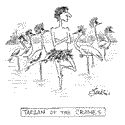 |
Tarzan Of The Cranes (Man in pond with skirt of feathers and standing on one foot.) |
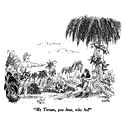 |
"Me Tarzan, you Jane, who he?" (Tarzan to Jane who is cuddling with an explorer.) |
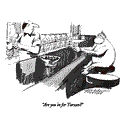 |
"Are you in for Tarzan?" (Bartender to ape who is sitting at bar.
|
 |
"One word, gentlemen-'Ungowa!' " (Tarzan to meeting.) |
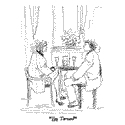 |
"You Tarzan?" (Man to woman.) |
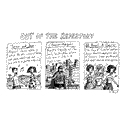 |
Out of the Repertory (Three operas based on stories, comics, and television series.) |
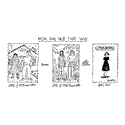 |
HOW SHE GOT THAT WAY Series of 3:
|
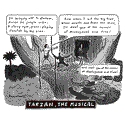 |
Tarzan The Musical (Tarzan is singing from his treehouse, while down below him is an elephant
chorus.)
|
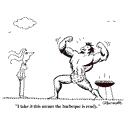 |
"I take it this means the barbecue is ready." (Woman talking to Tarzan type, who's beating his chest near the barbecue.) |
Peter Pigg 15mm Miniatures Tracy Griffin and Rob Greer are proud to announce the unveiling of a never-before-seen ERB figurines. These 15mm miniatures were first turned up by Tracy and are not currently found in the collections of our peers.One of the two known collections is currently for sale through an on-line silent e-mail auction (more details at the bottom of this text). Larger photo examples of single pieces of this collection can be seen at: http://www.jeddak.com/peterpig.html (Note: Page is no longer there.)
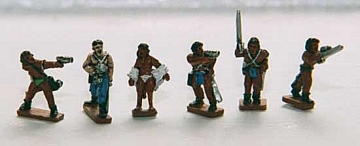 |
|
John Carter and the red warriors are garbed in blue breechclouts, the Amazons in green breechclouts |
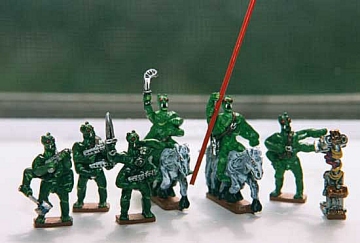 |
(27 in set) includes:
|
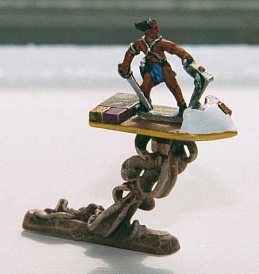 .
.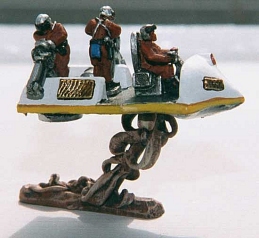
The photos do not do these figurines justice; the detail on them must be seen to be believed! Though small (the red warriors are 15 mm scale, the green warriors stand approximately one inch tall), the authenticity of the design is impressive. All stand on bases; the flyer bases consist of Martian vegetation. Only two sets were painted by Southern California's premiere hobby shop, which will take no more painting commissions.The three stage painting process includes the following stages:
1. A base coat is applied, according to the descriptions in ERB's novels;
2. Fine details, such as the green men's ivory tusks, harness buckles, and
the diadem in Dejah Thoris' crown are painted;
3. Finally, a black ink wash is applied to provide shadowing and texture.Both the designer and painter are fans of ERB's Martian series, and included details like the Martian warrior's pageboy-style haircuts and the green warriors' red pupils. Though the set is unlicensed by Edgar Rice Burroughs, Incorporated (hence, they're called "Green Martian Warriors" and "Red Martian Warriors"), it is clear that these figurines are based on Burroughs' immortal prose.
One set is owned by Scott Tracy Griffin, who has no intention of selling his--EVER. The other set is owned by Rob Greer and is currently for sale via private e-mail bids. The minimum bid for the set is $325. If it is a must have for your collection, the first person who offers $500 for the set via phone or e-mail will receive all bragging rights of owning this collection. All bids should be sent to rob.greer@brightstar.com. All bids will be handled on a first sent, first qualified basis. Ties will be resolved by the figures being awarded to the individual who first sent in their entry by the date stamp upon their e-mail.
PETER PIGG MINIATURES
The Official Peter Pigg Website in the UK features the Pigg miniatures:
http://www.peterpig.demon.co.uk/range5.htm
|
Master Sculptor I |
Master Sculptor II |
Photos ~ Sketches ~ Moves |
| . |
ERB's A Princess of Mars Illustrated |
. |
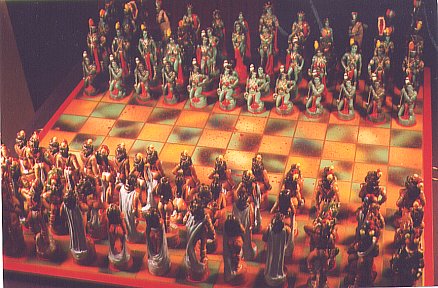
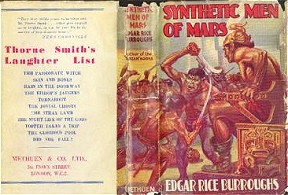 |
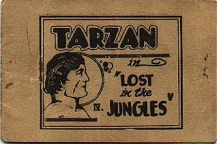 |
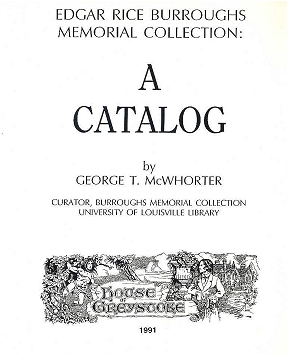 |
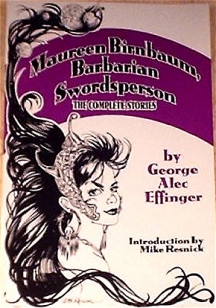 |
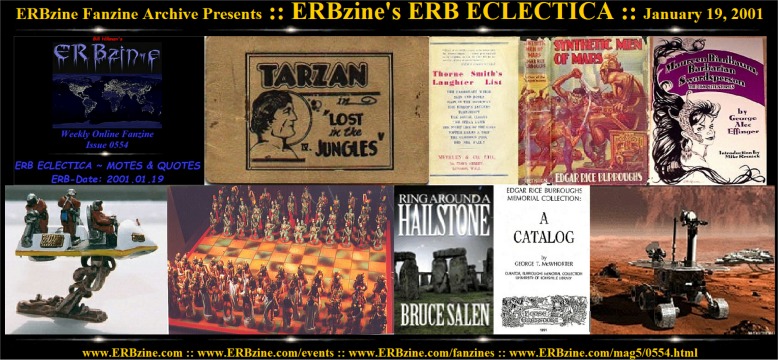
Click for full size PROMO SPLASH BAR
![]()
![]()
![]()
Volume
0554

BILL
HILLMAN
Visit
our thousands of other sites at:
BILL
AND SUE-ON HILLMAN ECLECTIC STUDIO
ERB
Text, ERB Images and Tarzan® are ©Edgar Rice Burroughs, Inc.-
All Rights Reserved.
All
Original Work ©1996-2008/2010.2022 by Bill Hillman and/or Contributing
Authors/Owners
No
part of this web site may be reproduced without permission from the respective
owners.